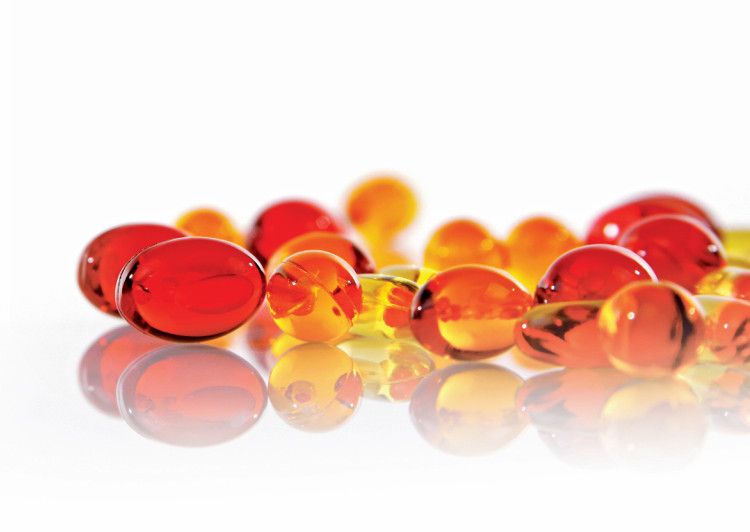Omega-3 market in 2019
Even in the face of an equivocal study or two-or concerns over sourcing, regulatory setbacks, and the occasional pharma-driven lawsuit-omega-3s retain a sterling reputation that other supplements can only envy.
Photo © iStockphoto.com/Gubcio

Like the little black dress, omega-3 fatty acids never really fall out of fashion. Their hemlines, so to speak, may rise and fall with the times, and they may get nudged to the back of the closet when a buzzier nutrient hits the racks with the fanfare of a flouncy new romper.
But as industry watchers and category insiders know, consumers always return to these fatty-acid classics. Why? Because the science is on omega-3s’ side.
“More than 4,000 studies have demonstrated that EPA and DHA play crucial roles in the healthy functioning of our hearts, eyes, and brains across all life stages,” says Chris Gearheart, director, member communications and engagement, Global Organization for EPA and DHA Omega-3s (GOED; Salt Lake City, UT). “They also support the health of expecting and nursing mothers and the development of their babies.”
So even in the face of an equivocal study or two-or concerns over sourcing, regulatory setbacks, and the occasional pharma-driven lawsuit-omega-3s retain a sterling reputation that other supplements can only envy. And they retain such a hold on our attention that it’s never too soon to revisit how they’re doing and where they’re headed next.
Going Places
From Kate Pastor’s vantage, omega-3s are headed toward good things. “Currently, the omega-3 market is stable,” says the senior vice president of Superba North America, Aker BioMarine Antarctic US LLC (Oslo, Norway), “but there’s great potential for growth.”
According to Grand View Research, omega-3s enjoyed an estimated market value of $2.29 billion globally in 2018, with a 7.4% CAGR forecast for 2019 to 2025. And while Grand View wagers that the active pharmaceutical ingredients market drives most of this growth, supplements and functional foods remain North America’s dominant application category.1
Gearheart attributes omega-3 supplements’ modest global growth particularly to consumers in the emerging economies of Southeast Asia, China, and India whose spending power is on the upswing. “This is in contrast to flat to slightly contracted omega-3 supplement demand in more established markets like the U.S. and Europe,” he says.
Taken to Heart
Nevertheless, Gearheart has faith that the flow of supportive science will keep omega-3s’ overall curve moving up and to the right.
The science linking the fatty acids with cardiovascular health still attracts the lion’s share of interest, and Gearheart notes that three major human trials studying EPA, DHA, and cardiovascular outcomes published in the second half of 2018 “effectively double the number of subjects who’ve been studied.”
Results of the ASCEND (A Study of Cardiovascular Events in Diabetes) study published in August 2018-though neutral on balance-demonstrated an 18% statistically significant reduction in vascular death risk among diabetic subjects supplementing with 1 g of omega-3s versus those taking an olive-oil placebo, Gearheart says.2
And while the VITAL (Vitamin D and Omega-3 Trial) study-which Gearheart calls “the first primary prevention trial in healthy subjects”-failed to attain its primary endpoint of reducing major cardiovascular disease risk, it did find a statistically significant 17% reduction in coronary heart disease risk and a 28% reduction in risk for myocardial infarction among subjects receiving the omega-3 drug Omacor plus vitamin D.3
The REDUCE-IT (Reduction of Cardiovascular Events with EPA Intervention Trial) study also looked at the effects of an omega-3 pharmaceutical-Amarin Pharma’s EPA-only Vascepa-on long-term cardiovascular events; recently published findings show that the drug, which delivers 4 g of EPA, reduced the risk of several negative cardiovascular outcomes by a statistically significant 25% or more, depending on the endpoint.4
Great Starts
“Because these three studies strengthen the body of evidence linking omega-3s to positive heart-health outcomes, GOED is working on a paper looking at omega-3 dose response, which we hope to publish this year,” Gearheart says.
That’s not all they’re looking at. The benefits of omega-3s for pregnant women and their babies are also on the organization’s radar, with results of a Cochrane review published in November 2018 proving especially heartening.
The study found that a daily dose of 500-1,000 mg of EPA and DHA for pregnant women decreased the risk of early preterm birth by 42%, preterm birth by 11%, and low birth weight by 10%. “The evidence was so strong that the authors stated ‘no further research is needed’ to be sure of the benefit,” Gearheart notes.5
Spreading the Word
The authors of the Cochrane study also published a set of best practices for doctors based on their results, which GOED translated into a consumer-facing infographic and a social-media-friendly video highlighting the importance of omega-3s during pregnancy.
In fact, GOED has spent several years developing educational materials for consumers and healthcare professionals, Gearheart says. AlwaysOmega3s.com offers consumers information on omega-3s’ heart, brain, eye, prenatal, and maternal benefits, while FatsofLife.com communicates those same benefits in greater scientific detail and with corroborating research to practitioners.
“As part of our consumer outreach, we’ve developed a library of infographics and videos we share on social media and with our members and industry to share with their audiences,” Gearheart adds. “In the healthcare-practitioner space, we’re running media campaigns or continuing education programs for nurse practitioners, physicians’ assistants, pharmacists, and registered dietitians, and we’ve sponsored education sessions at several practitioner events.”
As the scientific publications mount, GOED’s even shouldered the mantle of building a searchable clinical-study database “to quantify and clarify the research around omega-3s,” he says.
More evidence-based good news came in the form of FDA’s recent announcement of a qualified health claim for EPA and DHA. “Omega-3 companies can now link seafood, fortified food, and beverages and dietary supplements containing at least 800 mg of both EPA and DHA to a reduction in blood pressure, using very specific language,” Gearheart notes.6
FDA also updated its allowable upper limit for EPA and DHA in supplements from 3 g/day to 5 g/day for brands making the qualified health claim, he added.7
Krilling Me Softly
So the science and labeling fronts bring cause for contentment. Even better, the sourcing horizon is also looking up-and increasingly diverse.
“The omega-3 industry is unique in the wide array of EPA and DHA sources available,” Gearheart says. “Algal EPA and DHA are becoming more widely available, as are diverse sources like oil from hoki fish, calanus”-a marine copepod-“and herring roe. Each offers a marketing story to appeal to different consumer audiences.”
Pastor is happy to share krill oil’s story, noting that the market for the omega-3–rich oil “is heading into new territories like never before, especially in regards to science.” Exhibit A: A clinical trial examining krill oil’s effects on lupus patients began last year, bringing together the Lupus Research Alliance and Aker BioMarine. Chronic inflammation is a hallmark lupus symptom, and patients frequently exhibit low levels of omega-3 fatty acids-thus, researchers suspect omega-3s might help manage the disease’s attendant inflammatory effects. Trial results are expected in 2020.
Krill oil also evades some of the sustainability and traceability issues that dog other omega-3 sources. Within the past year, Aker BioMarine was “instrumental” in convincing most Antarctic-based krill-harvesting companies to voluntarily stop fishing in areas around the breeding colonies of penguins. Notes Pastor, “Companies in the omega-3 space continually need to invest in initiatives that help ensure the health of the biomass.”
And in terms of traceability, she continues, Aker owns and controls its entire supply chain, “which means we can ensure secure supply volume, product quality, and seamless service.”
Algae’s Alright
Meanwhile, algae’s potential as a renewable, non-animal omega-3 source keeps generating excitement within the industry.
Miguel Calatayud, CEO, Qualitas Health (Houston), calls algae-based omega-3 EPA and DHA “the perfect alternative to fish and krill oils: vegan, non-GMO, and fully traceable and sustainable.” No wonder his company, a leading algae cultivator, collaborated with ADM (Chicago) to launch a line of Onavita Algal DHA and Almega EPA blends for use in cognitive-, heart-, immune-, and eye-health support formulations.
ADM’s earlier algal-oil offerings comprised solely DHA, Calatayud notes, so Qualitas Health’s partnership introduces an EPA option to ADM’s catalogue. What’s more, “Partnering with ADM is a significant step toward our goal of bringing sustainable ingredients into the global supply chain,” he says.
As more algal EPA and DHA enter the market, brands must contend with the inherent difficulty of formulating and producing stable plant-based omega-3 products. As Barri Sigvertsen, senior marketing manager, consumer health and nutrition, Lonza (Basel, Switzerland), says, “To create an omega-3 supplement that delivers a plant-based positioning, it’s essential to consider both the ingredient and the delivery system.”
Their vegetarian Plantcaps capsules are “ideally suited” to delivering plant-based algal omega-3s, Sigvertsen says. Made from pullulan, a product of natural tapioca fermentation, they’re vegan, non-GMO, and vegetarian certified. They also provide a superior oxygen barrier to prevent the oxidation that makes omega-3 supplements both less palatable and less biologically effective.
Oxidation the Enemy
Steve Holtby, president and CEO, Soft Gel Technologies Inc. (SGTI; Commerce, CA), also understands the perils of oxidation. “It’s important to protect fish oils as much as possible through all handling steps,” he states. “Containing the fresh oil in an environment with minimal oxygen exposure, along with low-temperature manufacturing, maintains freshness.”
His company has developed a system for encapsulating omega-3 fish oils, pulling a vacuum and/or nitrogen-blanketing the ingredients during blending. They also molecularly distill the fish oils themselves to remove oxidized components and manmade pollutants, and they include the natural antioxidant d-alpha tocopherol in the formulation to forestall rancidity.
Outstanding in Their Field
Such innovations have gone a long way toward making omega-3 supplements reliable, effective, and increasingly commonplace.
But, says Karin Hermoni, PhD, head of science and nutrition, Lycored (Orange, NJ), “While we see many omega-3 products on shelves, the question arises: How can brands differentiate themselves and create innovative, powerful products? Cracking the code for how to elevate the power of omega-3s is a powerful asset for any brand looking to launch an omega-3 product.”
Her company’s contributions take their inspiration from the Mediterranean diet and capitalize on synergies between omega-3s and carotenoids like tomato lycopene and polyphenols such as carnosic acid. The tag-team formulations received patent protection in March for their “synergistic ability to balance inflammatory processes and reduce the secretion of cellular mediators from immune cells,” Hermoni says, citing research from 2017 showing that the omega-3/antioxidant combinations exert beneficial effects on microglia, neuron-supporting cells known to participate in cognitive processes, brain inflammation, and overall brain health.
“The brain-health market is on the rise in all demographics concerned with aspects like focus, attention, concentration, and memory,” notes Elyse Lovett, senior marketing manager, Kyowa Hakko USA (New York City). So given that her company’s branded Cognizin citicoline supplies nutrients that support brain function and protect it from free radicals, and that DHA “is known to fight free radicals, which is important for brain development,” Lovett says, “it made sense to combine the two ingredients to show how the ‘fighting power and protective power’ of the two could work together.”
A study of cognitively impaired mice showed synergistic activity that improved learning and memory, she continues. “From a marketing standpoint, we felt it’s important to deliver science to customers that shows the effects not only of Cognizin alone, but in combination with other potent brain-health nutrients.”
Finally, Sigvertsen notes, her company’s DuoCap capsule-in-capsule system lets brands deliver omega-3s plus trending ingredients like black seed oil and prenatal or multivitamins all in one dosage form. “This significantly broadens the spectrum of supplement combinations possible and offers supplement producers new opportunities to drive innovation and ensure that products stand out from the crowd,” she says.
For a little black dress like omega-3s, you couldn’t ask for more.
References:
- Grand View Research. “Omega 3 Market Size, Share & Trends Analysis Report By Application (Supplements & Functional Foods, Pet & Animal Feed, Pharmaceuticals, Infant Formulas), By Region (North America, APAC), And Segment Forecasts, 2019 – 2025.” March 2019. Accessed at: www.grandviewresearch.com/industry-analysis/omega-3-market
- Bowman L et al., ASCEND Study Collaborative Group. “Effects of n-3 fatty acid supplements in diabetes mellitus.” New England Journal of Medicine, vol. 379, no. 16 (October 18, 2018): 1540-1550
- Manson JE et al., VITAL Research Group. “Marine n-3 fatty acids and prevention of cardiovascular disease and cancer.” New England Journal of Medicine, vol. 380, no. 1 (January 3, 2019): 23-32
- Bhatt DL et al., REDUCE-IT Investigators. “Effects of icosapent ethyl on total ischemic events: From REDUCE-IT.” Journal of the American College of Cardiology, vol. 73, no. 22 (Jun3 11, 2019): 2791-2802
- Middleton P et al. “Omega-3 fatty acid addition during pregnancy.” Cochrane Database of Systematic Reviews. Published online November 15, 2018.
- FDA website. “FDA Announces New Qualified Health Claims for EPA and DHA Omega-3 Consumption and the Risk of Hypertension and Coronary Heart Disease.” June 19, 2019. Accessed at: www.fda.gov/food/cfsan-constituent-updates/fda-announces-new-qualified-health-claims-epa-and-dha-omega-3-consumption-and-risk-hypertension-and
- FDA letter. Accessed at: www.fda.gov/media/128043/download?utm_campaign=CFSANCU%20-%20FDA%20Announces%20New%20Qualified%20Health%20Claims%20for%20EPA%20and%20DHA%20Omega-3&utm_medium=email&utm_source=Eloqua

Prinova acquires Aplinova to further increase its footprint in Latin America
April 7th 2025Prinova has recently announced the acquisition of Brazilian ingredients distributor Aplinova, which is a provider of specialty ingredients for a range of market segments that include food, beverage, supplements, and personal care.

























